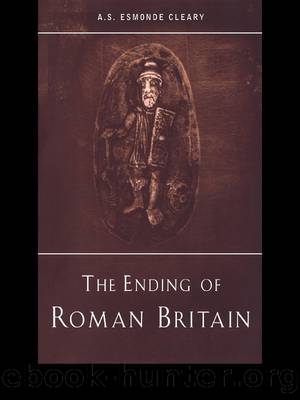The Ending of Roman Britain by Esmonde Cleary A. S

Author:Esmonde Cleary, A. S. [A.S. ESMONDE-CLEARY]
Language: eng
Format: epub
Publisher: Taylor & Francis (CAM)
Published: 2011-07-31T16:00:00+00:00
Fig. 28 Plan of Bradley Hill
Fig. 29 Plan of Chalton
The Celtic sources259 (admittedly post-Roman), on the other hand, suggest that partible inheritance was the norm for these people. Under this system the landholding instead of descending intact through the generations would be split equally between the heirs. Theoretically this could be taken to an absurd extreme. Social relations such as marriage must somehow have controlled this tendency. This could, though, have been one reason why individuals were reduced to the status of colonus as their property ended up too small to be viable. It may also suggest one reason why villas were absent from some areas. Villas imply a reasonable level of resources, if only to build and maintain them. In an area with a long history of partible inheritance it may have been that the tenurial landscape was too fragmentary to permit of the accumulation of the resources necessary for a villa. One of our sources for Celtic practice, the Llandaff charters of the late sixth century on (cf. p. 187), also displays a feature common to such late Roman and late-Roman-derived (Vulgar Latin) property law. This is the confusion between possessio and dominium—legal title and overall lordship.
All these factors will have made land ownership in late Roman Britain a lot more complex than appears from a simple consideration of the archaeological distribution maps. It must be the case that many farmsteads were in some way dependent on the local villa. It may be that they lay on the estate of the villa and were the dwellings of the estate’s labourers or coloni. It is noticeable that very few villas have any provision for housing a labour force. Alternatively the farmsteads may technically have been tenurially independent, though their occupants paid rent or owed labour service to the villa-owner. Such an arrangement would be in line with what the Classical sources tell us of the structure of Celtic society. Combined with the possibility of partible inheritance amongst the more Celtic elements of the population, this may explain why so many remained at the farmstead level. It may also mean that an estate was not simply a tract of land, but also a network of social obligations and responsibilities. Thus production could have been organised through social relations as well as expropriative ownership. This would have meant a social reality far removed from the archaeological dichotomy between villa and farmstead.
This must also warn us against acceptance of models for the operation of the Romano-British countryside which oppose romanised villas with native farmstead. Currently much debate about the Romano-British countryside is conducted explicitly or implicitly along these lines. Villas, along with towns and other ‘Roman’ sites, are seen as expressions of a Mediterranean-derived economy and society that worked over and alongside, but separate from, a continuing indigenous tradition of subsistence agriculture represented by the farmsteads. The relationship was essentially exploitative, and social relations moved only one way in the hierarchy. Obviously villas and towns were manifestations of and dependent on Roman institutions; that is a central tenet of this book.
Download
This site does not store any files on its server. We only index and link to content provided by other sites. Please contact the content providers to delete copyright contents if any and email us, we'll remove relevant links or contents immediately.
| Africa | Americas |
| Arctic & Antarctica | Asia |
| Australia & Oceania | Europe |
| Middle East | Russia |
| United States | World |
| Ancient Civilizations | Military |
| Historical Study & Educational Resources |
Room 212 by Kate Stewart(4962)
The Crown by Robert Lacey(4690)
Endurance: Shackleton's Incredible Voyage by Alfred Lansing(4627)
The Iron Duke by The Iron Duke(4253)
The Rape of Nanking by Iris Chang(4103)
Joan of Arc by Mary Gordon(3979)
Killing England by Bill O'Reilly(3927)
Say Nothing by Patrick Radden Keefe(3845)
I'll Give You the Sun by Jandy Nelson(3329)
Shadow of Night by Deborah Harkness(3262)
Hitler's Monsters by Eric Kurlander(3243)
Mary, Queen of Scots, and the Murder of Lord Darnley by Alison Weir(3123)
Blood and Sand by Alex Von Tunzelmann(3101)
Darkest Hour by Anthony McCarten(3040)
Eleanor & Park by Rainbow Rowell(3005)
Margaret Thatcher: The Autobiography by Thatcher Margaret(3003)
Red Famine: Stalin's War on Ukraine by Anne Applebaum(2846)
Book of Life by Deborah Harkness(2835)
The One Memory of Flora Banks by Emily Barr(2745)
